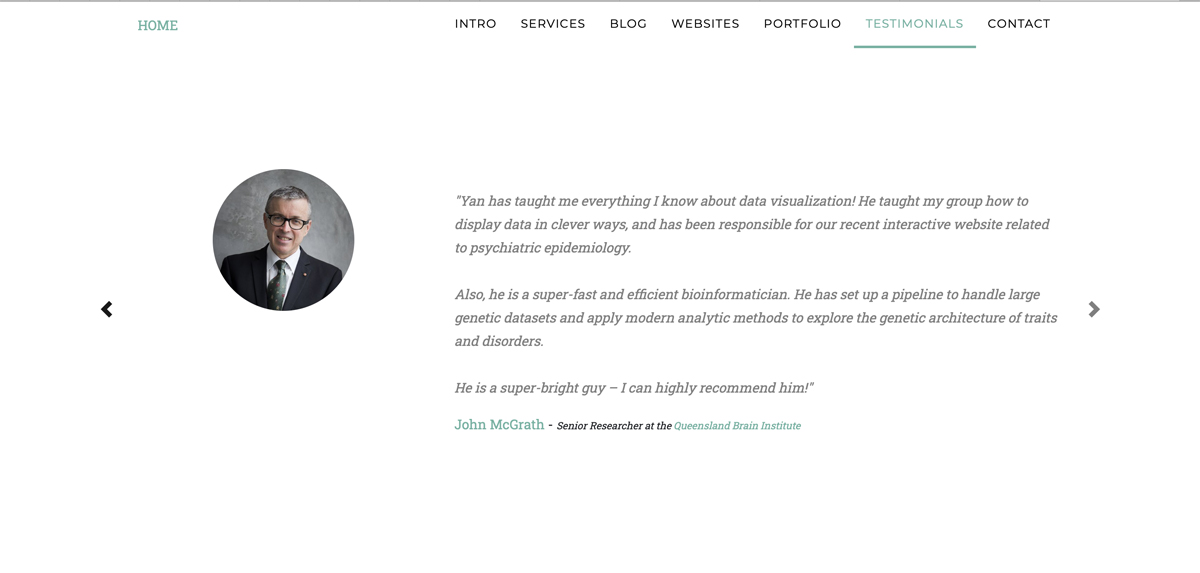A strong data analytics portfolio is a vital part of any job-hunting process. It should be eye-catching yet substantial.
It also needs to balance your work achievements, technical skills, and personality. That’s no small task for one little website!
In this post, we share five best practice tips for creating a job-winning data analytics portfolio. We’ve kept them discrete but focused, meaning you can apply them whether you’re starting from scratch or polishing up your existing portfolio. Click on each of the headings below to jump straight to the one you want:
- Highlight your key skills and services
- Include compelling client case studies and testimonials
- Build a blog to showcase your skills and interests
- Inject some personality into your data portfolio
- Focus on presentation
Let’s take a closer look.
1. Highlight your key skills and services
Including services on your data analytics portfolio may sound like an obvious first step, but it’s surprising how many neglect to include a services section at all. If you’re not sure what to put, ask yourself: What do you want to offer, and who do you want to offer it to?
For example, is your aim to be an all-round expert who can support the entire data analytics process? Or do you want to focus on a specific aspect of it? Consider the following services, which we found listed on real data analytics portfolios:
- Data mining and data collection
- Data cleaning and data management
- Data analysis
- Data visualization
- Teaching, training, or tutorials
These are key skills for all data analysts. However, they are quite general, and many portfolios focus on just two or three of these, drawing out more detailed aspects of each. Specializing in a single area is more likely to help you stand out and, depending on the kinds of roles you’re going for, may get you more work.
That said, it depends on the audience, of course. If the hiring manager is a data analysis expert, being too general may suggest that you’re inexperienced or lack the prerequisite skills. On the flip side, if you’re sending your portfolio to an HR or talent acquisition specialist (who might not have a general knowledge of the field) being too technical might put them off.
It’s therefore a good idea to choose your target audience early on and focus on your personal strengths. This will help you decide which methods, techniques, and tools you want to offer. Provide one or two sentences for each service offering, highlighting where your skills lie. But keep it concise. For inspiration, we highlight some useful techniques and analysis methods in this guide.
If you’re new to data analytics, it’s OK to keep your services more generalized. However, it’s a good idea to focus on your strengths as your experience grows. For instance, if data visualization is your thing, what do you focus on? Creating dashboards? Interactive reports? Perhaps you’re certified using a particular software tool, such as Tableau? Draw out your interests and balance them against in-demand skills.
Whether you focus on a few specialist areas or keep it general, the most important thing is that you highlight what you can do clearly and prominently on your portfolio.
2. Include compelling client case studies and testimonials
Case studies and testimonials are the most important part of a seasoned portfolio.
They do much of the heavy lifting in terms of highlighting your technical skills, experience, and backing up the services you offer.
If you’re completely new to data analytics and don’t have any real-world experience, don’t worry—you can include case studies based on hypothetical or passion projects.
Case study best practice for your data analytics portfolio
Case studies should be clear and concise, and they should support your service offering.
This can be a tricky balancing act, and it’s easy to write too much. There are various case study formats available, but a simple and popular method that is well-suited to data analytics is the problem, solution, outcome approach:
Problem
Describe the business problem you’re confronted with.
For instance, perhaps you worked at a transport and logistics firm that was looking to reduce their carbon footprint?
Or a hospital looking to cut costs and improve patient care?
Solution
Describe the process you undertook to solve the problem.
Which data did you gather? What kind of analyses did you carry out?
If relevant, what deliverables, e.g. reports, dashboards, data architectures, did you provide? What ultimate insights did you glean from the process?
Outcome
Explain how you helped improve the situation. How did your work (or recommendations) impact the business?
If possible, include measurable results, such as revenue increase, % reduction of carbon emissions or patient mortality, and other key performance indicators.
Using these headings as a guide, you can add additional ones as needed. For instance, “process”, “target audience”, “prototype”, or “lessons learned” can all be helpful headings. You don’t need to write a lot. In fact, it’s better not to. Just provide the information that a reader needs to get a clear picture of the project.
Visuals and design
Finally, if there are any visuals associated with the project (such as snazzy data visualizations or screen grabs you can use) try to include a couple with your case study.
Better yet, link to the project itself, for example on GitHub, as an embedded R Shiny app, or a Tableau project.
You can see an excellent example of how to lay out a neat case study on the portfolio website of data analyst David Venturi.
Testimonial best practice for your data analytics portfolio
Not all projects lend themselves well to compelling case studies. In these cases, happy clients can help.
If you have a good relationship with a client or past employer, ask them to provide a testimonial for your website. Having a strong, well-worded recommendation makes a big difference. Surveys have shown that a high percentage of consumers rely on testimonials when deciding how to spend their money. Businesses (and employers) are no different.
When asking for a testimonial, it’s fine to suggest to the person what you’d like them to include. For example, if you worked with them on a broad-ranging data project but specifically want to promote your sentiment analysis skills, you can ask them to focus on that aspect of your work.
Two or three testimonials will really lend your portfolio credibility. Try to include a photograph of the person who provided the quote, along with their name, job title, and the organization they work for. All this will help humanize any testimonials and make them more convincing to a hiring manager. It goes without saying, always make sure you get express permission in writing before including any of this information on your portfolio (you don’t want to get into hot water!)
This testimonial on data visualization specialist Yan Holtz’s portfolio perfectly captures everything you need.

3. Build a blog to showcase your skills and interests
If you haven’t yet worked on projects that are suitable for case studies, there are other ways to highlight your skills as you build experience—such as a blog.
A blog can serve multiple functions, including:
- Showcasing personal ‘pet’ projects
- Reflecting on the latest trends in data analytics
- Describing the data analytics processes or writing mini-tutorials
Personal projects
A blog is great for highlighting personal projects that don’t fit under the case studies section of your portfolio.
For instance, if you’ve taken a structured course that resulted in a sample project, include it here. A blog is also a neat way of linking to projects hosted elsewhere online, e.g. projects carried out in your free time.
Reflect on the latest trends
Reflecting on current trends in the field will prove that you nurture a genuine interest in data analytics.
You could discuss the latest data analytics topics that interest you or reflect on recent news articles. If you’ve been personally published anywhere, you can even include links to your work. Why not incorporate additional media to spice up your portfolio, too? This might include a personal vlog, tutorials you found helpful, or work from fellow data analysts.
Describe data analytics concepts
In lieu of work experience, use your blog to explain some complex data analytics concepts.
For instance, provide tips on how to use MS Excel formulas to clean data, or describe how to scrape the web using Python. By explaining complex topics in simple terms, you’ll demonstrate your technical expertise and communication skills—both vital for any data analyst. Data analyst Naledi Hollbruegge does this very well.

4. Inject some personality into your data portfolio
So far we’ve discussed practical techniques for promoting your data analytics skills, i.e. honing your service offering and using case studies, testimonials, and blog posts to support this.
While these are the most important aspects of your portfolio, personality counts, too.
Effectively showing your personality is vital because it hints at how you’ll work with others. This is trickier than our first three tips because it involves highlighting your soft skills in a more subtle manner. You need to create a discreet narrative that weaves throughout your portfolio.
While a job application or resumé is usually more formal (find a guide to writing a winning data analyst resumé here), a portfolio is your place to shine. Here are a few suggestions:
- Demonstrate your skills using datasets that interest you. For instance, if you’re interested in fitness, why not create a project using data from your Fitbit or Garmin? Alternatively, you’ll find some interesting datasets in this guide.
- Use your About page to describe your personal journey. Is it funny? Serious? Geeky? Decide how you’d like to be seen and weave this into your narrative.
- Include a suitable photo (or photographs) of yourself. Don’t be afraid to share a picture of yourself doing something you enjoy, such as hiking, walking with your dog, or something else that reflects your outside interests.
- Choose a template for your website. Unless you’ve built your website from scratch (kudos, if so!) consider investing in a custom template that reflects your personality better.
- Inject a little humor. Where appropriate, use headings or splash images to add a little whimsy to your website, but do so sparingly.
- Include other interests. If you have hobbies that are professionally appropriate, why not create a dedicated page to highlight them?
While you don’t need to do all of these things (remember: Your portfolio still primarily needs to project an image of a qualified professional), choosing one or two will help turn what might otherwise be a rather dry portfolio into something more eye-catching.

As you can see above, data scientist and machine learning engineer James Le isn’t afraid to use his portfolio to let his personality shine through via his photography.
5. Polish up your data analytics portfolio
Creating effective content for your portfolio (i.e. tips one through four) should be your priority.
This means providing a clear service offering supported by projects, case studies, testimonials, and a dash of personality. Once that’s done, though, it’s time to focus on the overall presentation.
Ensuring your portfolio presents in a clear, appealing way involves giving a little consideration to the user experience. Luckily, you don’t need to be an expert in UX design to apply some basic principles to your portfolio. All you need is common sense and a keen eye for detail—traits that many data analysts already have.
The first thing to ask yourself is: What do you want people to do when they visit your portfolio? Contact you? Explore your GitHub projects? Visit your social media? Read articles you’ve written? Whatever your aim, keep in mind where you want visitors to end up. This will help you create a user journey that guides them to that specific goal.
Clearly communicating your offering with a logical user journey will demonstrate to employers that you understand the importance of presentation. This might seem secondary, but if you can’t get your message across on your portfolio, what does this say about your ability to carry out and share insights from complex statistical analyses?
On a more practical note, we highly recommend including any actual presentations you’ve produced. This might be a report on an interesting dataset that you’ve analyzed, an algorithm you’ve coded presented in a Jupyter Notebook document or even just a slide deck you’ve produced. Practical, real-world examples are always better as they reflect work you’ve already carried out.
Final thoughts
Follow our five tips for your data analytics portfolio and you’ll soon have a portfolio that helps you stand out from the crowd.
Remember, though, that your data analytics portfolio is not a static project—you can update it as your experience grows, tweak it, change it as you see fit, and even amend it to suit certain jobs that you’re applying for. Don’t worry if it’s not perfect. Treat it like a work in progress, and it can actually be a lot of fun.
Finally, while creating a detailed portfolio might feel like a lot of work upfront, it’s guaranteed to ensure you have a stronger online presence and a compelling business offering. The initial investment in time and effort will be more than worth it once you’ve got your dream job.
If you want to learn more about a career in data analytics, try this free, five-day data analytics short course. You’ll find more portfolio advice and inspiration in the following guides:
